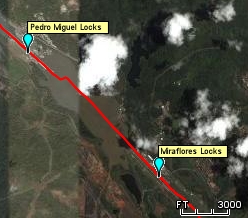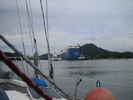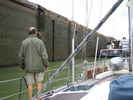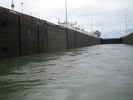Pedro Miguel LocksAs we made the short, 15 minute or so, crossing of Miraflores Lake, Larry was on the radio with the Lock Master who told him that, for this next lockage, we would be doing a "special" lock. Instead of following the large ship into the right hand lock as, as we had done in the previous two locks, we would be going through the left hand lock with just another single tug for company. They did this to speed up the process. In essence, we were going to pass up the large ship because it takes longer to process it than our small boat, and the Lock Master is always trying to move things along. Time is definitely money on the Panama Canal! Whereas we paid a paltry $700 or so for the privilege of passing through the locks, the large ships pay $100,000, $200,000, or even $300,000 for a transit, so the administration goes to great lengths to quickly move as many boats through as possible. As Larry pointed out the large green mechanical arrow at the head of the lock turning from right to left, indicating we should go into the left lock, Frank hurriedly directed the crew to move the extra tires and bumpers from RHAPSODY's starboard side over to the port side. The tugs always tie to the outside wall of the lock, and so this time the tug would be on our left. As we pulled into the lock, we were directed along to the very front of its 300+ yard length, where our new tug was already tied off. This time it was an older model tug, and so did not have the high rub rail that had caused the problem with the previous tug, and soon we were tied off to it. Once again we offered Cokes to the tug crew and they accepted our thanks. Then the bells rang, the lock gates closed far behind us, and the lock began to fill with water. We felt quite special, knowing that each lock uses (& reuses) 26 million gallons of fresh water, enough to supply all of Los Angeles for a full day, as we looked back at the huge lock with only us and a tugboat in it. Note that Panama gets a huge amount of rainfall which fills Lakes Gatun and Miraflores, and provides all of the water for the locks. In fact, each lock, as well as Gatun Dam, have hydroelectric generators and all of the lights, pumps, locomotives, and other Canal equipment are all powered by these generators, with a surplus that is pumped into the Grid for the people of Panama. Equally interesting to note is that, apart from regular maintenance and the occasional upgrade of things like the locomotives, lighting and so on, the Locks are still using the original construction and technology that they were built with back in 1904-1914 when they first opened. It's amazing to think about it, and even more amazing to be here! When the locks were full, after about 15 minutes, and we had risen to the level of Lake Gatun, a full 93 feet above sea level, the bells rang once again and the gates in front of us opened up and we were about to enter some of the most famous parts of the Panama Canal. This time, however, after untying from the tug, we were instructed to make our way out the lock first, with the tug following us. It was quite a relief. Not only was there no backwash from a huge ship in front of us, but by going first, all I had to do was put RHAPSODY in forward and steer clear of the tug. Much better than going backwards and stopping and trying to control her. Soon we were clear of the Pedro Miguel Locks. We were making very good time, as it was still only about 11:30 am. We had heard from several boats that had gotten hung up into the afternoon clearing this lock, and that meant that they had to spend the night moored on Lake Gatun, because ACP will not let private yachts transit locks at night. In fact, they had had to wait until 3:00 the following day before going through the (final) Gatun Locks, but we were making such good time that we estimated we would cross Lake Gatun and be at the locks to the Caribbean sometime around 3:30 p.m.Safely out of the locks, everyone settled down for a nice lunch. |




